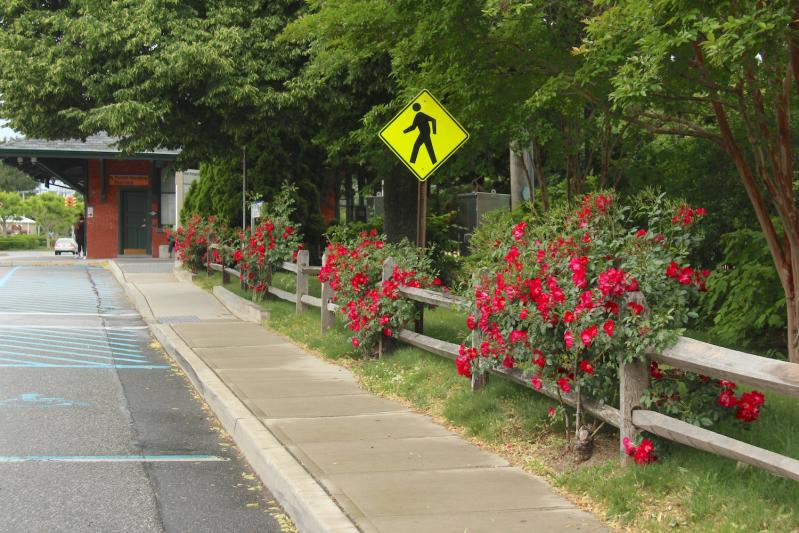Removing an eastbound lane on Main Street, reconfiguring the Reutershan parking lot, and redevelopment of the Gingerbread Lane/Railroad Avenue district were among the ideas voiced during last Thursday’s virtual workshop on an update to East Hampton Village’s comprehensive plan.
Last updated in 2002, the plan will guide future zoning decisions to align them with the community’s goals for land use, housing, transportation, and environmental sustainability. It is intended to ensure that decisions impacting the village’s growth are not made in isolation, but rather are part of a coordinated effort to promote orderly development, protect resources, and enhance quality of life while creating consistency in land-use policies and balancing competing interests.
An in-person workshop in December saw a series of straw polls and smaller-group discussion of issues before findings were shared with all participants. In that meeting, more shopping offerings for year-round residents and reducing traffic congestion were popular goals, along with more restaurant offerings and maintaining or improving the village’s look and feel. Addressing speeding in residential neighborhoods, congestion in the village center, and new pedestrian crosswalks were also supported. There was also broad agreement on the importance of water quality and conservation, stormwater management, and protection of plant and wildlife habitat.
Two-thirds of the 40-odd participants in last Thursday’s workshop identified themselves as village residents, the remainder were evenly split between those living in East Hampton Town and elsewhere.
Whereas the first workshop focused on existing conditions and identifying issues and opportunities, the virtual meeting examined a preliminary vision and strategies, with Noah Levine and Emily Tolbert from BFJ Planning of Manhattan, the consultancy engaged by the village, leading the process.
The “big idea” pitched by the consultants was a study of a “road diet,” the removal of an eastbound lane on Main Street. “The justification for such a change,” Mr. Levine said, “would be to significantly improve safety by reducing vehicle speeds and reinforcing the pedestrian-oriented character of the village center.” The roughly 10 feet of extra space, he said, could be repurposed to create bicycle lanes, a wider sidewalk, shorter pedestrian crossings, or a landscaped median. A rough analysis suggests that traffic flow would not be significantly impacted, he said, but a full New York State Department of Transportation study would have to be conducted. The D.O.T., he said, would explore the idea further if the village were to formally request it. “It does open the door for meaningful enhancements.”
In a two-question straw poll, however, “Don’t even consider this idea” was the choice of 32 percent of respondents. Another 29 percent chose “I’m doubtful about this idea, but it’s worth studying,” with the same percentage choosing “This idea is really exciting, and should definitely be explored.” Participants were then asked, if there were extra roadway space, what is your priority? Forty-five percent said bicycle lanes.
In the Reutershan lot, “there are circulation challenges that make it difficult for drivers to navigate,” with its narrow, two-way lanes, Mr. Levine said. “There’s no dedicated space to walk in the parking lot, so pedestrians are forced to kind of mingle with traffic.” Design options include introducing angled parking and one-way lanes, which, he said, would establish a clearer flow of traffic within the lot. This, he added, would return the lot to an earlier configuration, pointing to a 1978 depiction. That design, however, has slightly fewer spaces; the present layout, with its perpendicular parking, was designed to maximize capacity, he said. “Ultimately, there’s a tradeoff to consider between maximizing capacity and enhancing the overall experience for pedestrians and drivers.”
In another poll, nearly half of respondents said that some loss of parking is acceptable in order to improve pedestrian safety, circulation, landscaping, or streetscape, while almost a quarter said that maximizing parking should be the priority.
Also proposed was a “smart” parking solution that would guide motorists to available spaces, “perhaps reducing unnecessary circulation and making the village center more accessible,” Mr. Levine said. This, he said, could involve cameras with automated monitoring capability to track real-time usage across parking areas, which could be communicated through digital displays to help drivers quickly locate open spaces.
Compared to other commercial areas, the Gingerbread commercial district, including Railroad Avenue, has the greatest potential for new development. Zoning is “relatively permissive,” Mr. Levine said, with the biggest obstacle to commercial and residential development being a lack of sewers. “Sewers would unlock the ability to provide apartments on upper floors or some ‘wet’ uses, such as restaurants,” he said. Were that to be implemented, it would be prudent to update the area’s zoning in advance, he said, “ensuring appropriate building scale, parking quality, and access, while preserving the village’s historic character.” An affordability requirement could be incorporated into residential development, he suggested.
The largest land use in this area is Riverhead Building Supply, occupying just under four acres. “While there are some smaller businesses, the district generally lacks the critical mass and cohesion of a true commercial center,” Mr. Levine said. Ways to “knit this to the downtown village core” are being examined, he said. Two-thirds of poll respondents felt that some mixed-use development in the area would be reasonable.
Preliminary strategies to preserve residential fabric included strengthening zoning controls on massing, gross floor area, lot coverage, and basements, according to the consultants. Strict construction protocols should be established for new residences and major renovations, including restricting weekend construction during the summer. Stronger regulation and enforcement of short-term rentals was also recommended.
A straw poll asking about the main issues of overdevelopment returned “aesthetics and character” as the top consideration, followed by loss of green cover, maximized basements and overcrowding, disruptions during construction, and lack of on-site parking.
Members of the small groups that engaged in further discussion then summarized their findings for the larger group. More green spaces and pollinator and rain gardens should be prioritized, Ms. Tolbert of BFJ Planning said of one group’s conclusions. What can be done about the commercial core “shutting down” in the off-season, they asked.
Speaking for another group, Billy Hajek, the village planner, said that three themes had emerged: maintaining historic character, affordability for commercial and residential uses, and moving people rather than cars. Creative ways to get people downtown without making them drive should be explored, he said.
Joe Rose, who sits on the zoning board of appeals, said that circulation, traffic, and pedestrian and cyclist use of roadways were of paramount importance. There should be options for a swimming pool for various age groups, he said, echoing earlier musing about a pool in Herrick Park.
Speaking for the same group, Frank Newbold, a former chairman of the zoning board and chairman of the historic preservation committee, said that “these are not isolated improvements” and suggested that the Y.M.C.A. East Hampton RECenter be developed as more of a “neighborhood facility” together with the nearby Gingerbread district. The group was positive about housing above businesses there. On Further Lane, speed bumps and a dedicated bicycle lane would improve safety, he said.
Another group agreed that some roads do not feel safe for pedestrians or cyclists, Mr. Levine said, and discussed the appropriateness of bicycle lanes. There is concern, he said, about whether the village remains a village in a colloquial sense, its local charm being lost to a changing residential fabric and businesses encroaching on residential areas.
Lastly, he said, many proposed changes target the summer months, yet the needs of the year-round community should be kept in mind.
A third workshop, at which a draft plan is to be presented, is to happen in the summer, followed by further review and public hearings before an updated comprehensive plan is considered for adoption.




